We specialize in small set screws.

Akiruno-city Tokyo JAPAN
Flat point set screw type and uses
|
Fasten the round bar directly (Fig. 1) 
|
Fasten the D-CUT flat part of the round bar (Fig. 2) 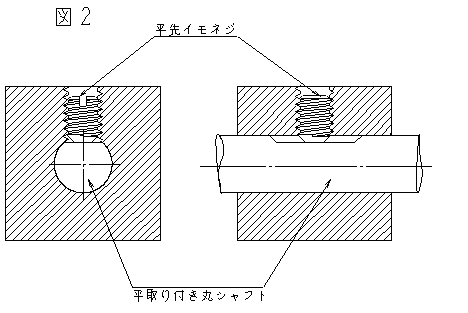
|
Used as an adjusting screw (Fig. 3) 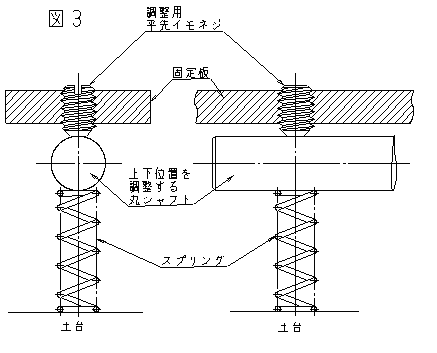
|
Fasten the round bar directly with the flat point set screw.
When the round shaft is soft and the set screw is harder, the outer diameter surface of the round shaft will be scratched. If the outer diameter surface of the round shaft is scratched, it will become difficult to move when readjusting the round shaft. In such a case, flatten the shaft as shown in Fig. 2.
(Fig. 1) Click the figure to see the enlarged view.
Fasten the D-CUT flat part of the round bar with the flat point set screw.
It is used when you do not want to scratch the outer diameter surface of the round shaft. However, it takes some time to align the set screw with the D-CUT flat part of the round bar during assembly.
If you use the D-CUT flat part of the round bar to fasten it, you can also use a cone point set screw or a cup point set screw to bite the set screw into the mating material and fasten it more firmly.
(Fig. 2) Click the figure to see the enlarged view.
Used as an adjusting screw the flat point set screw.
Right-angle accuracy and flatness accuracy of the tip of the adjustment screw are important for the accuracy when adjusting the position. If the flat part of the tip of the adjusting screw is slanted or the flat surface is rough, no matter how accurately the adjusting screw is turned, the shaft cannot be adjusted accurately and finely.
And if you want to make finer adjustments, we recommend changing the screw pitch from coarse to fine.
(Fig. 3) Click the figure to see the enlarged view.
Cone point set screw type and uses
Fasten on a conical dint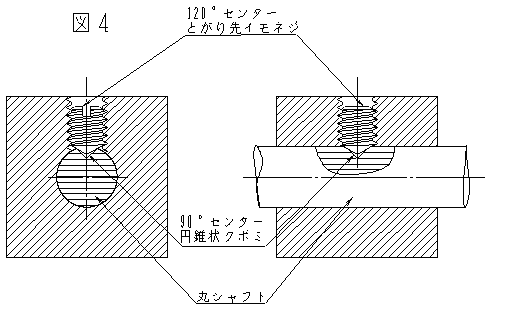
|
Fasten on a concave groove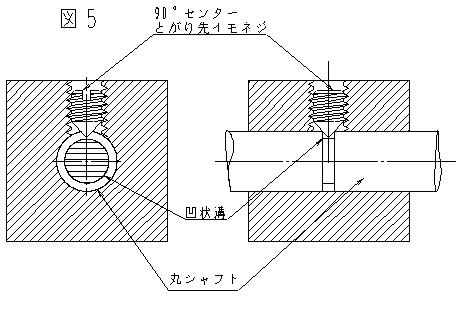
|
Fasten to the conical dint with a cone point set screw.
This is an example of how to use it as a set screw for positioning in the longitudinal direction and the rotational direction by attaching a conical dent on the outer peripheral surface of the round shaft and dropping the pointed tip of the set screw into it.
The standard tip angle of the pointed set screw is 90 degree, but the one with the shortest set screw length is 120 degree. Also, some people call the "cone point set screw" the "conical set screw".
(Fig. 4) Click the figure to see the enlarged view.
Fasten to the concave groove with a cone point set screw.
This is an example of how to use it as the set screw for positioning in the longitudinal direction by making a concave groove (or V-shaped groove) around the outer peripheral surface of the round shaft and dropping the tip of cone point set screw.
If the set screw is harder than the round shaft, the round shaft will be damaged when the set screw is tightened. After that, when the set screw is loosened, the round shaft may not move smoothly.
(Fig. 5) Click the figure to see the enlarged view.
The tip of cone point set screw is also used when it bite into the other party to stop that. In order to bite into the other party, the cone point set screw tip must be harder than the other party.
Dog point set screw type and uses
The rotation of the round bar is regulated by the keyway and stopped in the longitudinal direction.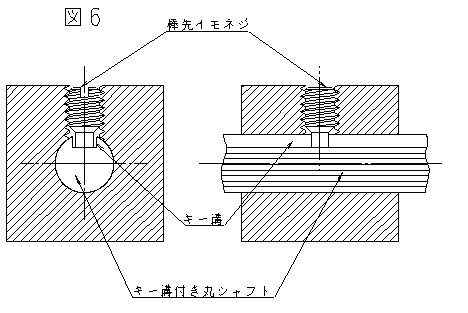
|
The rotation of the round bar is regulated by the keyway, and the longitudinal direction is free.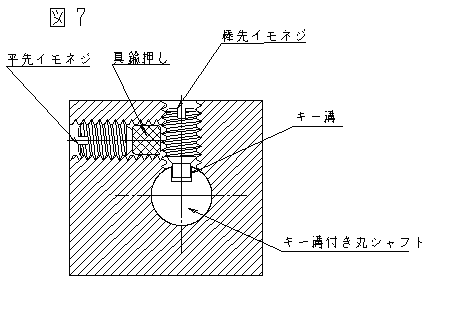
|
The rotation of the round bar is regulated by the keyway and stopped in the longitudinal direction.
This is an example of how to use it for positioning in the longitudinal direction while controlling the rotation by dropping the tip of dog point set screw into the keyway and stopping the bottom of the keyway at that tip.
This uses the dog point set screw as the set screw for a round bar with a keyway.
(Fig. 6) Click the figure to see the enlarged view.
The rotation of the round bar is regulated by the keyway, and the longitudinal direction is free.
This is an example of how to use the tip of dog point set screw as a simple round key by dropping (floating) that tip into the keyway of the round bar.
This is one method used for structures that constrain the keyway shaft in the direction of rotation and allow it to move freely in the longitudinal direction.
(Fig. 7) Click the figure to see the enlarged view.
At this time, the tip of the dog point set screw is not pressed (floating), so the following measures are required to fix the dog point set screw. Each has advantages and disadvantages, but the horizontal screw method shown in Fig. 7 is complicated to process, but it is the preferred method as a mechanically reliable fixing method.
- There are various methods for fixing the dog point set screw.
-
As shown in Fig. 7, it is a method of stopping from the side with a flat point set screw using "brass pusher".
If you push directly from the side with a flat point set screw without using "brass pusher", that tip may damage the thread of the dog point set screw.
As a countermeasure, fix the dog point set screw with a "brass pusher" made of brass, which is softer than the thread of the set screw. If there is no permanent readjustment of the dog point set screw, "brass pusher" is not necessary. -
It is a method of adhering the threaded part of the dog point set screw.
I think it's difficult to glue the threaded part accurately, but it's a good idea to do it well. This is a very effective method when there is no space for machining screws from the lateral direction. -
It is a method of swaging the threaded part of the dog point set screw.
However, I think it is difficult to swage the threaded part accurately and to confirm it. -
It is a method of lengthening the threaded part of the dog point set screw until it out side
and tightening it with a double nuts.
If you lengthen the screw part and it out side tighten it with the double nuts, the balance will be lost in the rotating body, and it will get in the way.
Oval point set screw type and uses, and Our thoughts
It is used in almost the same way as a flat point set screw. Theoretically, the oval point set screw hits the mating side at one point in the center of the screw tip, so it is unlikely that the mating material will kink when tightened.
It is similar to a cone point set screw in that it hits the other side at one point in the center of the oval point set screw tip. However, the oval point set screw is characterized by being less likely to damage the other side and being less likely to deform its own tip.
Also, when adjusting the position by touching the tip of the set screw to the flat surface on the other side, the oval point set screw is effective for fine adjustment because the surface runout of the tip is small when it is turned.
However, if you need to make further fine adjustments when using the set screw as an adjustment screw, we recommend that you use a finer screw thread.
It is a photograph and a figure of a brass adjustment screw with a oval tip of M2xP0.25 (finer screw thread).
(Reference: The screw pitch with a nominal diameter of M2 has a coarse screw thread is 0.4 mm and a fine screw thread is 0.25 mm.)
We manufacture the threaded part with a cutting tool, there is no problem in finer screw thread.
In addition, there is a difference in the R shape (dimensions) of the rounded tip between the old JIS standard (B1117-1980) and the new JIS standard (B1117-1988). The old JIS standard (B1117-1980) is a standard established in 1980, and the new JIS standard (B1117-1988) is a standard established in 1988.
- Below, we will compare the rounded tip shape of M2.
-
The figure on the left is the old JIS standard (B1117-1980),
which specifies the height of the round tip = 0.4 mm. -
The figure on the right is the new JIS standard (B1117-1988),
which defines the radius of the rounded tip = R2.8 mm. -
In the old JIS standard (B1117-1980), the height of the R part was a little basket like,
and the new JIS standard (B1117-1988) the height of the R part is a little flat.
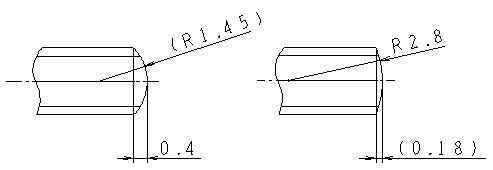
I (Koji SAIDA) prefer the old JIS standard R shape in the figure on the left, so I adopted the old JIS standard R shape in the DEL standard.
Also, the oval point set screw is in the JIS standard, but not in the ISO standard.
The oval point tip of the hexagon socket set screw had a standard in the previous JIS standard (B1117-1988), but it is not in the JIS standard (B1117-1997) currently in use.
Cup point set screw type and uses
It is used to bite the cup tip of a cup point set screw into the other party (flat surface or outer peripheral surface of the shaft) to stop it.
In order to damage the other party (flat surface or outer peripheral surface of the shaft), the set screw tip must be harder than the other party.
Case of hurt the other party
Use the cup point set screw or cone point set screw when you want the tip of the set screw to bite into the other party and attach it firmly.
Make the tip of the set screw harder than the hardness of the other party.
Case of not hurt the other party
If the shaft is scratched when you remove it later, it will be difficult to remove it, so use it when you do not want to scratch the shaft.
Flat point set screws are recommended as a general shape.
It is necessary to make the hardness of the tip of a set screw softer than the hardness of the other party.
If you cannot make such a difference in hardness, or if you want to fasten the outer circumference of the screw with a set screw from the side, it is better to insert a "brass pusher" between the set screw and the other party.
See Fig. 7 for "brass pusher".